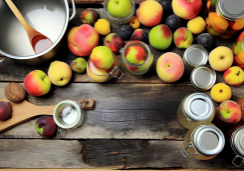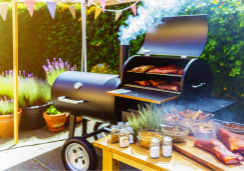What's Essential for Smoking Meats at Home?
As you embark on the culinary journey of enhancing meats with the whisper of smoke, you'll quickly realize that the art of smoking at home is both a science and a craft.
You need the right equipment, of course—a reliable smoker that fits your space and budget. But beyond the hardware, your success hinges on the quality of the meat you select and the wood that imparts that coveted smoky flavor.
You'll also want to master the temperature and timing, which are crucial for that perfect tender bite. As you look around for more information, consider the nuances of rubs, brines, and the patience required to elevate your home-smoked meats from simply cooked to a flavor-filled experience that dances on the palate.
Are you ready to discover the key elements that will transform your backyard endeavors into a savory success?
Choosing the Right Smoker
To unlock the full potential of your home-smoked meats, it's crucial to select a smoker that aligns with your culinary aspirations and lifestyle. Whether that be a versatile Kamado grill, a user-friendly pellet grill, or a classic smoker designed for the art of temperature control. You're not just buying a grill or smoker; you're investing in an experience that elevates the smoking process to an art form.
Your choice of smoker should cater to the type of wood you'll use. Wood chips like hickory or cherry infuse distinct flavors, so ensure your smoker can handle the smoke intensity these woods provide.
A Kamado grill, with its ceramic construction, retains heat and offers the versatility of using charcoal or wood.
If convenience is your priority, a pellet grill automates temperature control, allowing you to focus on the meat's flavor profile.
Selecting Quality Meats
Having chosen a smoker that suits your needs, it's equally important to select quality meats, ensuring your smoking efforts culminate in delectably tender results. The cuts of meat you choose are foundational to your success, so it's crucial to make informed decisions.
- Best Meats for Smoking:
- Pork Belly: Offers rich flavor; ideal for slow cooking.
- Spare Ribs: Fatty and flavorful; they're a smoked meat classic.
- Brisket: Requires skill but rewards with incredible taste and texture.
To guarantee the quality, visit a local butcher or utilize a reputable meat delivery service. They can provide expert advice on the type of meat that'll work best with your smoker. For instance, a thick cut of meat not only withstands the long cooking process but also ensures that the flavor is deeply infused.
When preparing to cook meat, remember:
- Meat should be thawed completely for even smoking.
- Wrapping in butcher paper can help retain moisture and develop a desirable bark.
Don't shy away from fattier cuts; they often grant the most succulent smoked meat experiences. Your passion for smoking meats will shine through with every tender, perfectly cooked cut of meat that you serve.
Understanding Wood Types
Selecting the right wood type is as crucial as choosing the best cut of meat when aiming to master the art of smoking meats at home. The wood you choose is the heart and soul of meat smoking, infusing your BBQ with aromatic smoke that's essential for that mouthwatering, delicious smoked outcome.
Different woods impart unique flavors—fruit woods like apple or cherry offer a milder, sweeter touch, ideal for poultry and seafood, while robust hardwoods like hickory or oak deliver a potent, smokier punch, perfect for the richness of pork and beef.
When it comes to smoking, it's not just about the wood type, but also how you use it. Low and slow is the mantra, allowing the wood to smolder and caress the meat with its flavorful smoke. Be mindful of ventilation to prevent smoke overkill; you're aiming for a hint of smokiness, not a bitter cloud.
Dare to experiment with various wood types and even mix them. Wood Pellets offer a consistent burn and are great for trying out different wood combinations. Remember, the key to great smoking meats is a dance between the meat and the wood—each step, each choice, leads to a uniquely delicious smoked creation.
Mastering Smoking Techniques
While the right wood sets the foundation for flavorful smoke, mastering the techniques of meat smoking elevates your BBQ to the realm of culinary artistry. Selecting a smoking apparatus that allows for precise temperature control is crucial. You'll want to keep a steady temperature range between 225°F to 275°F.
Here's how you can assure your meat emerges juicy and tender every time:
- Temperature Control and Charcoal Management
- *Monitor Temperature*: Constantly keep an eye on the temperature reading. Adjust vents to maintain low heat.
- *Charcoal Usage*: Use about 5 kilograms of good-quality charcoal briquettes. The amount of charcoal you need may vary depending on the smoker and the meat's size.
- *Consistent Heat*: Add more charcoal every hour or so to sustain the temperature for the long haul.
- Meat Preparation and Smoking
- *Quality Meat*: Choose thick cuts from a reputable butcher. Thaw thoroughly before smoking.
- *Salting and Seasoning*: Generously rub coarse sea salt and your chosen seasonings into the meat.
- Observation and Sauce Application
- *Vigilant Eye*: For the first three hours, especially, keep an eye on the smoke and heat.
- *Saucing*: If you're using BBQ sauce, apply it during the last 30 minutes to prevent burning.
Maintaining Proper Temperature
To achieve the perfect tenderness and flavor in your smoked meats, it's critical to maintain a consistent temperature within the sweet spot of 225°F to 275°F. As a Grill Master, you know that the art of smoking is a delicate dance with heat. To ensure you don't miss a step, you need to smoke with precision, and that's where a reliable grill thermometer becomes your partner. It allows you to monitor the inferno within your smoker, alerting you to any fluctuations that could compromise the cooking process.
Managing the heat requires finesse, especially when using Charcoal. The adjustable vents on your smoker are like the valves of a trumpet, fine-tuning the melody of smoke and heat. If the temperature soars, don't panic. Use oven mitts to carefully position Aluminum Foil to lower the temperature, shielding your precious cargo from the heat's intensity. And don't forget to check your meat thermometer. It's the secret weapon that ensures your meats aren't only smoked to sublime perfection but also safe to devour.
Frequently Asked Questions
What Supplies Do You Need to Smoke Meat?
You'll need a keen eye for meat quality, precise temperature control, and a sense of the right wood selection to give your smokes that perfect flavor profile. Don't skimp on marination methods either!
What Do You Put on Meat Before Smoking?
Before smoking, you'll rub your chosen meats with flavorful dry rubs or immerse them in rich brine solutions to enhance taste. Proper meat preparation, including fat content consideration, ensures a succulent smoke flavor.
What Is the Secret to Smoking Meat?
The secret lies in patience and practice. Master temperature control, choose the right wood, and manage smoke quality. Understand humidity's role, select marbled cuts, layer flavors, maintain heat consistency, and honor the resting period.
What Is the Easiest Thing to Smoke for Beginners?
You'll find pork shoulders forgiving for your first smoke with their fat content buffering temperature fluctuations. Prioritize meat quality and monitor with an internal thermometer to ensure succulent results every time. Keep practicing!
Conclusion
You've got what it takes to smoke meats like a pro. Choose a reliable smoker, invest in top-notch meat, and learn your woods.
Master the techniques, control the heat, and don't skimp on the rubs. Remember, patience is your secret ingredient.
Keep experimenting, learn from every brisket and rib, and trust the process. Your dedication will pay off—soon you'll be serving up smoky perfection that'll have friends and family begging for your secrets.
Keep smoking and savor the journey.










